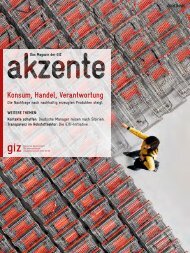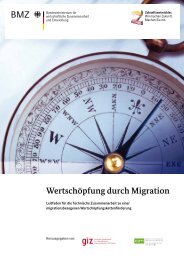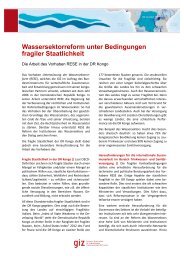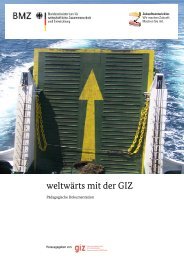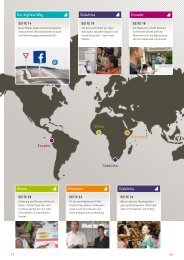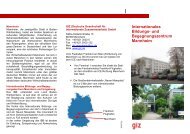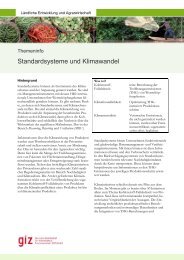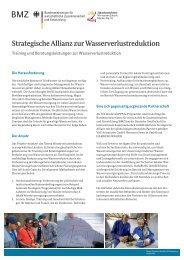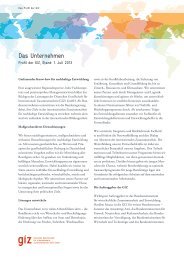Complete issue (pdf, 12.56 MB, EN) - GIZ
Complete issue (pdf, 12.56 MB, EN) - GIZ
Complete issue (pdf, 12.56 MB, EN) - GIZ
You also want an ePaper? Increase the reach of your titles
YUMPU automatically turns print PDFs into web optimized ePapers that Google loves.
The link between education, prosperity and democracy<br />
South Korea has enjoyed<br />
steady growth over the past<br />
three decades. The young<br />
industrialised nation has<br />
already overtaken the av <br />
er age level of development<br />
of OECD countries, and at<br />
fifteenth in the Human Development<br />
Index ranks as<br />
one of the world’s most developed<br />
nations – ahead of<br />
Denmark, Belgium and Austria.<br />
In the OECD Programme<br />
for International Student<br />
Assessment (PISA) study<br />
on education, South Korea<br />
performed best out of all<br />
OECD participants. The high<br />
level of education in South<br />
Korea is seen as one of the<br />
reasons for its economic<br />
upturn – and this in turn<br />
has provided a sound platform<br />
for political transformation.<br />
In the late 1980s,<br />
the country began to put<br />
past authoritarian regimes<br />
behind it. As a top-transformer,<br />
it now ranks seventh<br />
out of 128 in the Bertelsmann<br />
Transformation<br />
Index – with a broad democratic<br />
consensus in both<br />
institutions and public life,<br />
as well as a flourishing<br />
civil society.<br />
Good training improves employment prospects<br />
All around the world, opportunities for those in the employment<br />
market increase in line with their level of training. The following graph<br />
shows the employment rates for 2009 as a percentage of the<br />
population segment between 25 and 64, based on educational<br />
qualifications.<br />
First and second step of basic education*<br />
Upper secondary and post-secondary non-tertiary education**<br />
Tertiary education***<br />
Germany<br />
54.9 75.5 86.4<br />
Brazil<br />
68.7 77.4 85.6<br />
OECD average<br />
56.0 74.2 83.6<br />
Israel<br />
44.3 69.0 82.4<br />
Mexico<br />
61.7 71.9 81.7<br />
USA<br />
52.5 68.9 80.8<br />
* International Standard Classification of Education (ISCED) Level 1 and 2; ** ISCED Level 3 and 4;<br />
*** ISCED Level 5 and 6. source: OECD, Education at a glance 2011<br />
20<br />
akzente 02/2012



